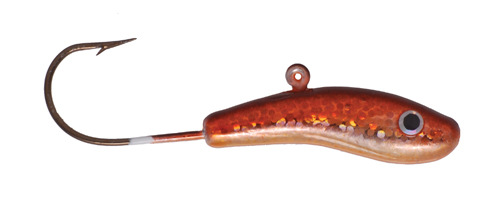 Safe-ice is coming soon to a lake near you. Here are some things to think about to make sure you start off the season with a bang. Ice Walleyes — Bottom-Pound, Bottom-Scrounge. Few techniques attract big walleyes like bottom pounding. The technique is to lift the jig and let it sink fast to the bottom, sending out an auditory “thump” and kicking up puffs of bottom silt as visual attraction. Repeated “pounds” bring fish in to investigate. Anglers lean toward heavier jigs with a weight-forward design like the Slick Jig for bottom pounding big walleyes.
Safe-ice is coming soon to a lake near you. Here are some things to think about to make sure you start off the season with a bang. Ice Walleyes — Bottom-Pound, Bottom-Scrounge. Few techniques attract big walleyes like bottom pounding. The technique is to lift the jig and let it sink fast to the bottom, sending out an auditory “thump” and kicking up puffs of bottom silt as visual attraction. Repeated “pounds” bring fish in to investigate. Anglers lean toward heavier jigs with a weight-forward design like the Slick Jig for bottom pounding big walleyes.
“I use this technique when the fishing is slow,” said Jon Thelen. “It’s effective when fish aren’t moving much, primarily during the slower daytime hours.”
Bottom pounding isn’t to be confused with bottom scrounging. Scrounging is emulating a feeding minnow that is darting and skittering along on bottom, and is tremendously effective when fish are actively feeding on minnows. The motion the angler imparts to the rod is similar to bottom pounding, but the jig should be flat on bottom and weighted to glide and spiral on the drop. Lindy’s Foo Flyer was designed for bottom scrounging. Tip it with a minnow and give it plenty of twitches to prompt an erratic, skittering action.

Always Use a Two-Pole (or More) Combo
Ice anglers don’t double their chances by using two poles. Using two poles with one dead-sticked and the other actively jigged increases your odds 10-fold when the fishing is slow. Use a spoon with lots of flash or a lure with an internal rattle to maximize attraction. A baitfish flash or auditory click from a rattle brings curious fish in to investigate. By having two distinctly different lures and actions close by, curious fish will have the option of taking your jigged offering or the dead-sticked live bait rig.
On your jigging presentations, a bright glow finish is important in dirty water, during low-light conditions and when there’s a heavy snow-pack that cuts light penetration. This makes it less important during first safe-ice when the fish are shallow and there’s no snow-pack. Whichever type of jigging lure you use, tip it with a minnow head. Use the whole minnow on your deadstick jig. Thelen suggests the No. 6 Frostee Jig.

Ice Panfish
Pay special attention to the top portion of the jigs you select, especially if you’re fishing deeper water. A jig with a wide, flat head like the Lindy Bug is easier for your electronics to pick up. Jigs like the Lindy Toad are great for shallower water when anglers need to punch through weeds. Both jigs feature a slightly offset hook for a better bite on the hookset.
Use glow finishes and use a Tazer to recharge it every 15 minutes or so. Panfish rely more on sight for feeding than other senses, and the glow makes it easier for them to see and accurately strike the jig.
“I don’t worry about hook color when I’m after panfish,” Thelen said. “I gob on euro larva or wax worms to completely cover the tip of the hook, anyway. I prefer euro larva because it comes in a variety of colors, but will have wax worms with me just in case it’s one of those days when they prefer them over the euros.”
By: Lindy Team
